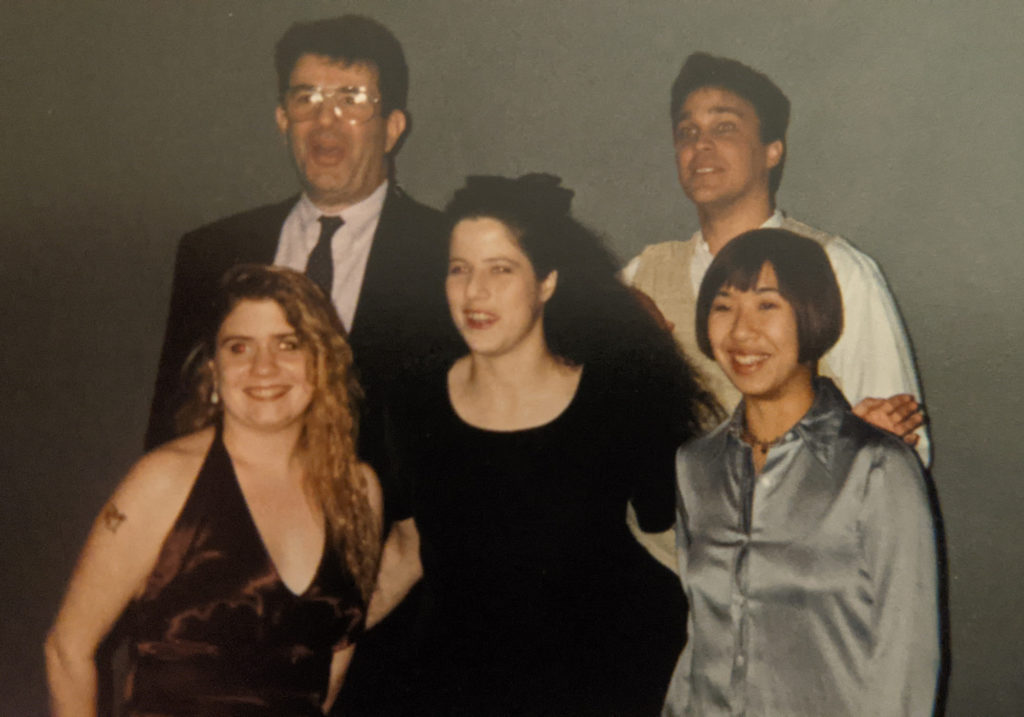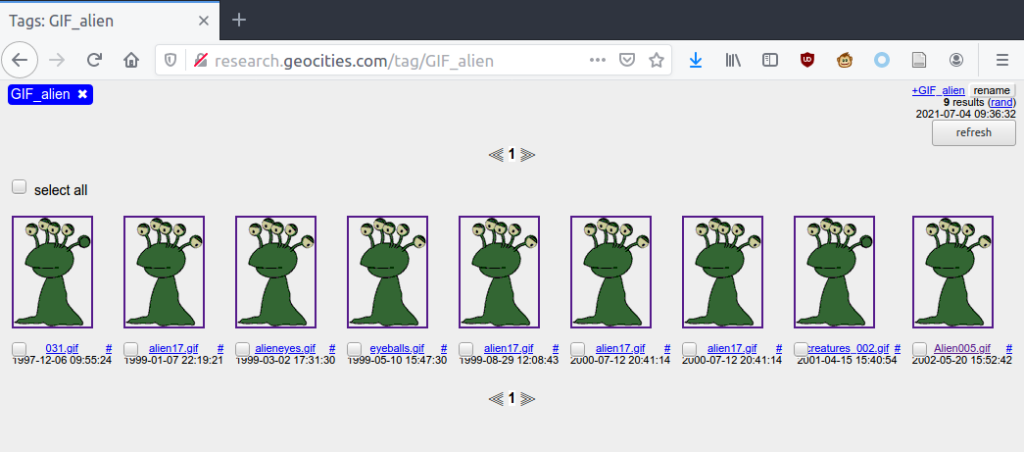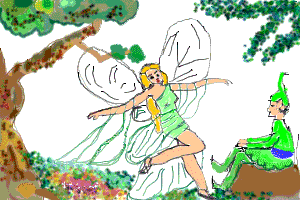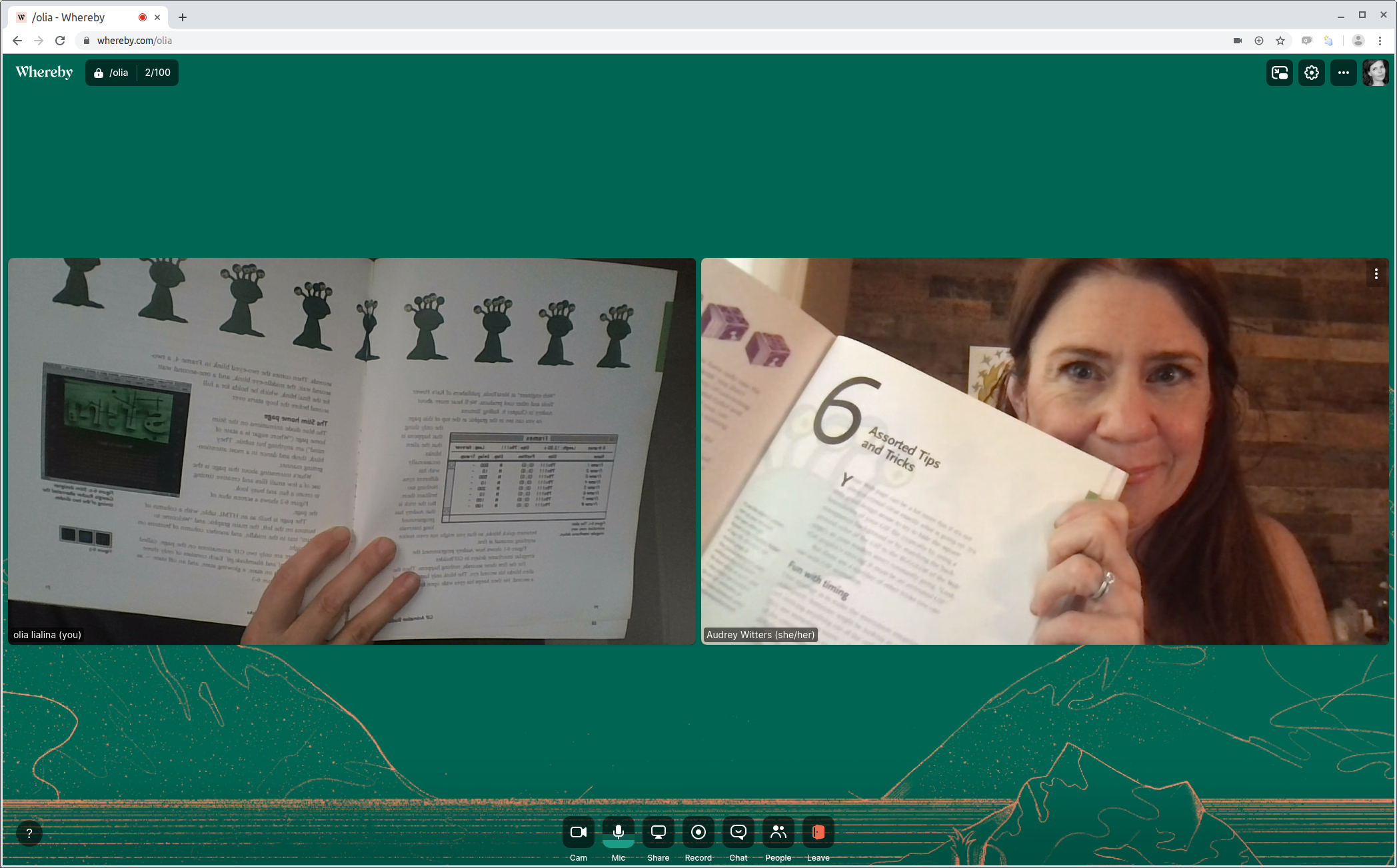⚠️ Some GIF mentioned in the text have a limited number of loops.
Consider hard refresh to see them in action again.



MetaTools web team Christmas party, 1995. Front row, left to right: Audrey Witters, Julie Sigwart, Rena Tom.
Back row, left to right: Michael Mogitz, Scott Fegette (Audrey Witters’ personal archive)
“Assorted Tip and Tricks”, chapter 6 of Richard Koman’s GIF Animation Studio manual, published by O’Reilly in 1996 starts with the wise remark “Your Web page can be a lot more fun if it’s not always crystal clear exactly what is going on” (p.69).
Meaning that animated GIFs can be used for more than just motion. They are the element that can bring surprise and suspense. To realize GIFs’full potential one could play with interframe delays and numbers of loops. Two essential properties in the mid 90’s; two more decisions early GIF makers could make, apart from transparency (or not) in the background of the animation and the amount of frames used in the animation.
As an example of the best practice Koman brings the Blinking Alien, attributing the authorship to Audrey Witters from MetaTools.
Today Audrey is a Managing Director of Online Executive Education at Stanford and she was very surprised that I wanted to talk with her about her alien.gif. The conversation started on Whereby on June 29, 2021; continued in Google docs the following days and concluded with the short video call on July 12.
Olia Lialina: Audrey, did you know that you are famous? That your GIFs and tips on how to make them were celebrated on the pages of GIF Animation Studio? Actually did you know at all that you were in the book and on the CD?
Audrey Witters: I did! And we have the book at home. I just have to find it!

Back in 1995, I began to work for MetaCreations (back then called MetaTools). We produced graphic arts software — Kai’s Power Tools was our big title then! And so, myself as well as three other folks at MetaTools were working on the website, we did everything together: design and coding, these weren’t separate jobs back in 1995. You didn’t have it segmented yet. One of the things we did to support the community and to promote the software was publishing web tips, I think they had a cute name, I can’t remember now.
OL: ![]()
AW: Yes! And so, I had published a tutorial on doing animated GIFs using Kai’s Power Tools.
OL: <title>Animation Rocks</title>
AW: And then the author of that book sent me a note saying “hey, I’m publishing this book on animated GIFs, can I use your stuff in it?” I checked with my boss, and we were like, yeah, it’d be free publicity for our software as well as our website. Let’s go! So, I guess that’s the story.
OL: A bit of a meta question: What did you think at that time about books like that? I ask because I also started to work online in 1995, and I remember that back then, I would really laugh at paper manuals and thought that they were just reprinting what we made. Making a book over a weekend by copy pasting our online work looked for me like the last thing to do. Not to mention that these books would become obsolete already a week after publishing. Of course now 20 years later I do really appreciate them since very often they are the only source of information and illustration for me.
AW: I don’t think I agree with you. In 1995, when I took the job at MetaTools, my dad questioned me. “Isn’t this web stuff going to be just a fad? Are you sure this is where you want to go?” He had just put a second mortgage on his house so I could finish my education. And so, I didn’t know, I don’t think I knew, is this the future? Or is my dad going to be right? And this is going to be the flash in the pan? I was young. So, I was kind of excited that somebody wanted my work in their book. The other thing I would say is that the publisher of this book was O’Reilly. And we did have their books in the cubicle, because you couldn’t find EVERYTHING on the internet in 1995. And also even if something was available, load times were kind of onerous, right? So, it was still more convenient to go to a book. We respected paper manuals at that time, because they were still easier to reference. It’s funny that you talk about how your appreciation for books has increased over the years, and mine’s gone in the opposite way: Now if I want information, I’m not gonna buy a book. I will look online.
OL: The manual introduces you as a “web engineer”, with quotation marks, probably to emphasize that the profession didn’t exist yet, and that you are a pioneer in this field. Do you remember what you called yourself at that time? And how did it happen that you started to work at MetaTools? What did you study?
AW: I studied electrical engineering, my actual thought was that I was going to leave college and design concert sound equipment. I’m a really big fan of live music. And that’s sort of where I thought I would go. But in summer, I would work for the satellite data services division of National Oceanographic Atmospheric Association, which is a part of the US Department of Commerce. I programmed databases in FoxPro, to support people who would want to get certain satellite images… Boring… But then one summer in 1994, they came by and said, “hey, there is this thing called the worldwide internet or something, I don’t know. Can you have the intern look at it?”
So, I started learning about the internet in 1994. I would come into work, I would get on to my computer, I would log into the University of Illinois, because there was a list updated every day of all of the web pages that existed on the internet. So, I would turn the computer on, I would go to that page, it was going to take forever to load. So, I would go make coffee, then I would come back and there would be this list. And the new links would be blue instead of purple. So, I literally saw every day how the web was growing. MTV was there. Adam Curry was there very early on. A few people had webcams of coffee machines and I think vending machines, so they didn’t have to walk down the hall to see if there was a full pot or the candy they liked. There was a rather raunchy site called Bianca’s Smut Shack that NOAA probably wouldn’t be too excited I spent time looking at! I think Pizza Hut made a website that summer – which was cool because we could imagine what would later become “e-commerce”.
There was a person, I think it was a male grad student at MIT but I’m not positive, who posted a picture of his lunch every day. It struck me as very absurd. Of course, it’s maybe not a lot different from Instagram today!
It was weird that I programmed a super boring website about satellite data and satellite data images. But it was one of the first ones.
OL: You were the first webmaster at the National Oceanographic Atmospheric Association?!
AW: Right, I made their first web page, which was one of the first federal government web pages, I think the Department of Defense was ahead of us. It was fun, because it was new. It was way more fun than programming databases in FoxPro.
OL: Noaa.gov is listed in a lot of my old web catalogues, like the Whole Internet and WWW Atlas, but without any screenshot. The earliest Wayback machine could bring me is May 1997 Can it be that it is still your design?


AW: That is crazy to see! No — first of all, I don’t think you can properly call either this or what I did “design”! It was more functional, though I think I did try to include some images (including the round logo on those pages!). I remember it with a gray background. But also, I created a website for a teeny tiny division of NOAA called Satellite Data Services. It maybe didn’t even still exist in 1997! It was the first one *at* NOAA, but I didn’t make a website for all of NOAA.
… In 1995 I finished my degree, I sent out my resume and I didn’t get any nibbles on it. So actually, I moved to California because of my best friend. One day her boyfriend’s ex-colleague told about this job at an internet startup (it wasn’t like a little tiny startup, about 100 people, but it was still pre-IPO). And I was one of the few people who had actually had web experience at that time. So was hired as well as a woman named Rena Tom. And we were really good compliments for each other because she was far more artistic and she did the technology as a hobby and I was far more technical and just sort of was tickled by the design and the graphics.
And as far as my title, I do not remember what my business cards said. It’s possible that I asked them to put engineer in my title to make my dad happy. But I don’t remember… Unofficially Rena & I actually were called the “Web Smurfs” – I guess because we were both kinda tiny. Rena still has that on her LinkedIn profile!
OL: You didn’t see yourself as a webmaster?
AW: I guess my boss would have called himself our webmaster back then. Yeah :))
OL: Back to the “Animation Rocks” website, that explains to web users what “animated GIFs” are and how to make one. Your 3 steps are very simple and charming.
- Make a bunch of gif images which vary from each other just a little
- Get a hold of a piece of software to put them together
- Use that software to create the animated gif
How did you learn to make GIFs?
AW: We learned everything the same way then: we’d see a cool new thing – animated GIFs, image maps, embedded MPEGs, fancy layout with invisible tables – and we’d look at the source code or reach out to the author and see what you could figure out. And if you got desperate, you looked up a reference on the web — or in a book! And you just sort of played with it, which was much better to do together.
OL: You provided the link to the GIfBuilder and GIF Construction set. And the link to the Netscape animation page. The latter wasn’t saved within the Internet Archive, but here is another early 1996 page on Netscape’s site that provides samples of GIFs and the link to the GIF portal.


![]()

![]()
![]()
![]()
I very much appreciate the eclecticism of this collection and the fact that none of the images are made at Netscape, they all are taken from the collections web enthusiasts were starting to create at that time…
… The GIFs that are published on your website, are they all yours or collaborations?







AW: For sure the alien.gif was a collaboration. I am almost positive that Julie Sigwart drew the alien. And then I made him blink. One of the engineers, Ian Gilman, taught me how to make smoke and how to make the smoke effect. And then I worked with him to figure out how to animate it. It was all really really collaborative and also a long time ago.
There were four of us. I had two bosses, Scott Fegette and Julie Sigwart. And my closest colleague, Rena. And we worked very very collaboratively together. So, I believe that the navigation bar, and the overall site kind of look and feel were designed by Scott. That was already there when I started in October of ‘95.

OL: It’s quite advanced navigation bar for 1995. It is an image map and an animation. But what is also interesting is that it is not a loop!
AW: That’s right. That was the navigation bar for the whole site. And then I don’t remember if it was me or Scott, but we animated it for this section of the website only. And only one cycle of animation.
OL:  is a very special one. Let me quote Koman’s elaborate protocol of your GIF: “…the trick is that Audrey has programmed long intervals between quick blinks, so that you might not even notice anything unusual at first […] For the first three seconds nothing happens. Then the alien blinks his second eye. The blink only lasts a tenth of a second. He then keeps his eyes wide open for a full five seconds. Then comes the two-eyed blink in Frame 4, a two second wait, the middle-eye blink, and a one second wait for the final blink, which he holds for a full second before the loop starts over.” You were proud of the trick? Did you feel that you were making something special, something new?
is a very special one. Let me quote Koman’s elaborate protocol of your GIF: “…the trick is that Audrey has programmed long intervals between quick blinks, so that you might not even notice anything unusual at first […] For the first three seconds nothing happens. Then the alien blinks his second eye. The blink only lasts a tenth of a second. He then keeps his eyes wide open for a full five seconds. Then comes the two-eyed blink in Frame 4, a two second wait, the middle-eye blink, and a one second wait for the final blink, which he holds for a full second before the loop starts over.” You were proud of the trick? Did you feel that you were making something special, something new?
AW: I think I was certainly aware that it was unique. I guess the word I want to use next is cheesiness. And one of the things that felt cheesy about animated GIFs was their super obvious loop. Mine were slower, they’re less bold and in your face. They’re not just animation, I don’t have exactly the right words, but they were trying to be a little bit less cheesy. We had the blinking work like blinking would be in real life, right?
And the other thing about the alien and other pictures on my page was their size. Load time of pages was a big deal in 1996. You were trying to see something on the web, but the whole page was like not loading because somebody had some big long animated GIF on it that ended up being just gratuitous. It was really annoying and so one of the things about the alien was that it was tiny, only 11,6 Kb.
OL: To quote you in 1996, “The alien’s eyes were just covered up with green by hand. The interframe delay was varied so that the blinks appear more random — longer delays here don’t cost you anything in file size.”
There is another animation on the same page where you slowed down interframe delays to almost one second. An elegant 6,6 Kb flower.gif, that could probably serve as a horizontal ruler.

Only nine frames and no loop at all. You only see how leaves and flowers appear. They don’t disappear and reappear forever.
 The man in the spotlight on the last page of your site. He is also not a loop!
The man in the spotlight on the last page of your site. He is also not a loop!
AW: The flower reminded me of something I’d have drawn by hand at the bottom of a page in a notebook. It was meant to feel like an end (or like you say, like a divider) but with a little bit of a flourish.
The “man” one I’m pretty sure was mostly Rena’s, So, I can’t say for sure, but I think the idea is — you come on stage and the spotlight turns on it doesn’t sit there and turns on and off. Right?
OL: Right! I think it is also something that disappeared with the first generation of GIFs. In their second reincarnation it is only about the loop, the eternal loop.
Another question I want to ask you: We now talk about the very early ears of GIFs but their popularity, their age was very short. Do you remember the moment when making GIFs or having them on a website was not cool anymore?
AW: They had a moment. In 1995, and 1996, right, we were desperate for our pages to feel alive on the web. People used computers to do things like they weren’t paper, so you expected them to be alive. And there weren’t a lot of ways for people to make a page feel alive, but GIFs were one. And many of them were terrible. I tried to make some that were not garish and awful. I don’t think enough people worried about this. GIFs were kind of ugly, in most cases. But we got better and the technology got better. Video came out, all these other things came out are way cooler than an animated GIF.
OL: I remember it happening in the beginning of dot.com, there was an idea that GIFs belong more to amateur web, to the past, because the future of the web has to look professional, corporate.
AW: It is related. When people started doing more commerce over the web, it got serious and animated GIFs did not feel serious to people for sure.
OL: Do you remember the moment when they started to come back? They did around 2007, and in fact became very dominant and a thing on their own. I think about a very wise remark on the second page of your site: “One key to using animation is to put it somewhere where it does something, rather than just sitting there being self-gratifying.” I think today GIFs are only self gratifying, they are not part of a navigation or a layout, they are not “doing anything”
AW: It’s interesting. I have children that are Gen Z. I am squarely Gen X and we are still a very ironic generation. But I think Gen Z and maybe the late millennials took this idea of ironic appreciation to a whole new level. And I don’t think there’s even the right word to describe the way they feel about retro things. I think there’s a little bit of tongue-in-cheek-ness about animated GIFs and how they’re showing up primarily as responses on social media.
I think it’s a manifestation of the way that that generation thinks about things. They are part of communication. So they are still doing something. I will tell you that my children were sending me face palm GIFs, when I told them I was gonna do this interview. I said, “your mom was a pioneer with animated GIFs.” And then they were like

OL: Back to the alien.gif. Have you ever seen it used on some other pages?
AW: No, I don’t remember ever seeing it used anywhere else.
OL: I did! It appears on GifCities, when you look for “alien”. We have six of them in the Geocities archive, they were used on 9 different profiles.

But what may disappoint  you is the fact the gif was altered. alien017.gif, alieneyes.gif, eyeballs.gif and others — they all are blinking in the same interval, and the interval is very short. 0,20 of a second.
you is the fact the gif was altered. alien017.gif, alieneyes.gif, eyeballs.gif and others — they all are blinking in the same interval, and the interval is very short. 0,20 of a second.
AW: Oh, they ruined it! That’s too bad. I was excited when you told me it got propagated because I don’t think I was aware of that, but then I’m a little sad if it got propagated incorrectly because unexpectedness of timing was the whole idea.
OL: I can’t say who made it or when exactly. I can only assume that the person altered the speed unconsciously, while cutting the alien out, in order to have it on a transparent background. All the variations have a transparent background. Yours is on the white one, which makes it more difficult to merge it with the background of the webpages.
![]() Another variation I found on the life web, on the Supra Owners Club forum actually. User Flip chose the alien to be his avatar. This time blinking appears to be less hectic, because the first frame stays on screen for 0,7 seconds, others are 0,20. But as you can see the size is altered this time it is 100×100 instead of your original 79×111. Probably to meet user pic requirements…
Another variation I found on the life web, on the Supra Owners Club forum actually. User Flip chose the alien to be his avatar. This time blinking appears to be less hectic, because the first frame stays on screen for 0,7 seconds, others are 0,20. But as you can see the size is altered this time it is 100×100 instead of your original 79×111. Probably to meet user pic requirements…
When I examined the code of your GIFs, I was surprised to see that you didn’t put your or MetaTools names in the comments.You were not thinking that you should put your name?
AW: No, I’m pretty sure that never occurred to me.
OL: Do you think that there are some other GIFs of yours somewhere? Did I miss some?
AW: I didn’t even remember most of these until you showed them to me. So, I don’t know. I had a Jazz drive, maybe even two of them. That had all my stuff when I left MetaTools. If there were more, they would be there. But I have no idea where those drives are. I don’t think I threw them out, but I haven’t seen them in more than 10 years. So, I don’t know if that counts as existing.
OL:  There is one more GIF on your site, it is a bit hidden. You wrote ”Here’s a cool bit of fire that was made in Photoshop, then processed in Adobe Premier with a roll effect and saved out as pict files. If you do this, just be sure to limit the number of frames you use. More than about 20 frames will make the file and thus the loading time bulky.” It has 16 frames and is 103,7 KB. Which is a lot for that time. It is probably why you didn’t put it on the page… Your fire made me think about other flames that I have in my collection.
There is one more GIF on your site, it is a bit hidden. You wrote ”Here’s a cool bit of fire that was made in Photoshop, then processed in Adobe Premier with a roll effect and saved out as pict files. If you do this, just be sure to limit the number of frames you use. More than about 20 frames will make the file and thus the loading time bulky.” It has 16 frames and is 103,7 KB. Which is a lot for that time. It is probably why you didn’t put it on the page… Your fire made me think about other flames that I have in my collection.
![]()


They are way too fast! Too few frames and no delay at all — just default 0,02 seconds make them unbearable. They were made for modem connection and slower computers. Today people don’t care about size or amount of frames… and 25 years ago not many thought that they needed to adjust their creations for high resolution screens, swift connection and CPU speeds measured in gigahertz. Sorry for talking so much, but I can’t miss the opportunity to share files from my “too fast folder” with a frame delay guru :)
![]()


And my question: do you see such GIFs on the web today? Something that obviously comes from the past?
AW: I don’t think I pay a lot of attention to it. I think there are a lot of artifacts on the web, things that are too fast, or pixelated images that have a reduced color palette, because there were only 256. I don’t see them that much, but maybe I’m not looking for them.
OL: How long did you stay at MetaTools? And what happened after?
AW: About three years from 1995 to 1998. I did end up moving from “web engineer” to doing more project management, and then product management for an online game we had on AOL.
OL: And then serious dot com business started?
AW: Yeah. In 1998, I was recruited up to San Francisco to work at a startup where I actually ended up managing the software engineering team. So, it made a lot more sense relative to my degree.
OL: The last page of your GIF tips <title>But Wait...</title> ends with
“That’s all for now, folks! If you’ve got comments, questions or wombats, feel free to send me some bits at audreyw@metatools.com! And thanks for droppin’ by…![]() ”
”
Did you get a lot of emails?
AW: Well.. I mean, I got an email from the guy that wanted to include me and my GIFs in his book!
OL: If you manage to find your copy of the GIF Animation Studio, can I ask you to meet online again for a webcam selfie with both copies?
…
July 12, 2021
AW/OL :


__
Other interviews in the series –> https://blog.geocities.institute/archives/tag/interview
One Response to Oral History: Audrey Witters